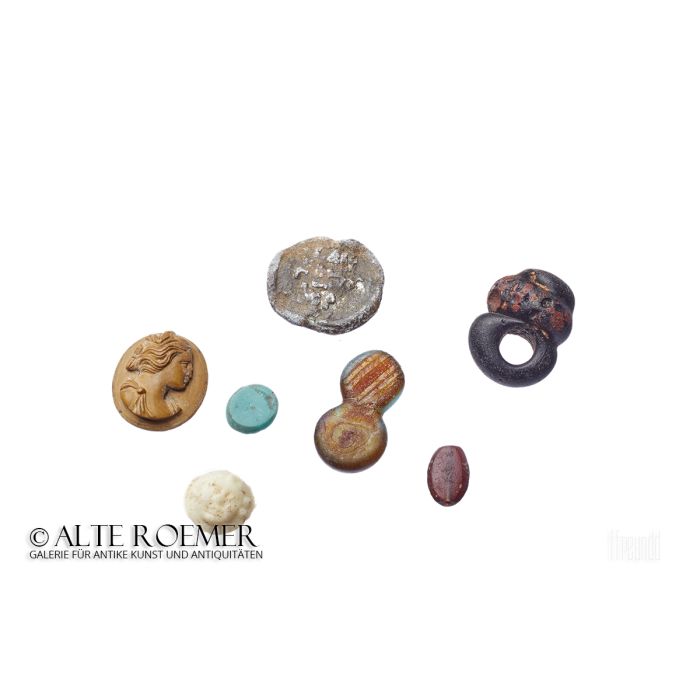Six ancient artefacts and one modern cast
Price: on request
Sold
Object number
AR1955
| Object: |
Six ancient objects and one modern casted gem
|
| Material: |
Glass, metal and molding paste.
|
| Period: |
The glass gems from Roman times. The polychrome glass decorations from the Islamic period. The lead bulla probably Byzantine. The casted gem from Modern Age. |
| Description: |
Interesting small group of 7 objects from the Professor Brosch collection of ancient gems. Ideal for beginners and all who enjoy further research on the objects. There are two ancient intaglios made of glass paste, dating from Roman times. The motif if any can't be determined. One of them with a longitudinal drill hole. A Roman cameo from the 2nd to 3rd century AD, presumably once set into a gold earring. In addition, two jewellery pendants made of multi-coloured glass, dating from the early Islamic period. The metal object has not been identified by us, but it is likely a lead bulla from the Byzantine era. Finally, one object is a modern cast of an outstanding Roman cameo. According to Prof. Brosch's notes, it is the cast of a piece from an 18th century collection. |
| Dimensions: |
8mm to 22mm.
|
| Provenance: |
From the German collection of Professor H. Brosch (1923 to 2009), author of historical publications, scientific museum advisor, decorated by the Order of Merit of the Federal Republic of Germany. The collection was built between 1960 and 1975. It was inherited to U. Buechner, Germany, and then acquired by us in 2013.
The Professor Brosch collection of ancient Gems: After the decline of the Roman Empire, ancient gems retained or regained recognition in medieval Europe. In addition to frequent reuse in church art, there were also profane uses. This is shown by the example of the ancient intaglio of Julia, daughter of Emperor Titus. It was reused in the 9th century by the Merovingians in the "Escrain de Charlemagne" and can be admired today in the French National Library. The reception of ancient glyptic during the Italian Renaissance resulted in a great fashion to collect gems, which could be entertained by the European educated bourgeoisie during journeys through the Mediterranean in the spirit of enlightenment and education. Thus Goethe, inspired by his trip to Italy, which was immortalised in literature, also built up a collection of antiquities. The collection of ancient intaglios by Professor Brosch is certainly a late classicist continuation of this tradition. The collection forms a systematic cross-section of the thematic diversity of ancient gems and has been worked on extensively with a scholarly approach. Professor Brosch had a great interest, not only in ancient history, but also in the more recent history of his home region. He was honoured with the Federal Cross of Merit for his achievements in the field of historical studies. It is with pride that we have fully documented this collection and provided it with literature references. We are now pleased to bring these miniature works of art from the ancient world back into circulation and to enrich a collection in the tradition of the Renaissance and Enlightenment in a worthy manner. If you are interested in purchasing the collection in its entirety, please do not hesitate to contact us. |
| Authenticity: |
We unconditionally guarantee the authenticity of every artefact, all items are subject to our lifetime return policy on authenticity.
|


